Related Research Articles

Cornelius Vanderbilt, nicknamed "the Commodore", was an American business magnate who built his wealth in railroads and shipping. After working with his father's business, Vanderbilt worked his way into leadership positions in the inland water trade and invested in the rapidly growing railroad industry, effectively transforming the geography of the United States.

William Henry Vanderbilt was an American businessman and philanthropist. Known as "Billy," he was the eldest son of Commodore Cornelius Vanderbilt, an heir to his fortune and a prominent member of the Vanderbilt family. Vanderbilt became the richest American after he took over his father's fortune in 1877 until his own death in 1885, passing on a substantial part of the fortune to his wife and children, particularly to his sons Cornelius II and William. He inherited nearly $100 million from his father. The fortune had doubled when he died less than nine years later.

Cornelius "Corneil" Vanderbilt II was an American socialite and a member of the prominent United States Vanderbilt family.
The Vanderbilt family is an American family who gained prominence during the Gilded Age. Their success began with the shipping and railroad empires of Cornelius Vanderbilt, and the family expanded into various other areas of industry and philanthropy. Cornelius Vanderbilt's descendants went on to build grand mansions on Fifth Avenue in New York City; luxurious "summer cottages" in Newport, Rhode Island; the palatial Biltmore House in Asheville, North Carolina; and various other opulent homes. The family also built Berkshire cottages in the western region of Massachusetts; examples include Elm Court.

From the late 1870s to the 1920s, the Vanderbilt family employed some of the best Beaux-Arts architects and decorators in the United States to build an unequaled string of townhouses in New York City and palaces on the East Coast of the United States. Many of the Vanderbilt houses are now National Historic Landmarks. Some photographs of Vanderbilt residences in New York are included in the Photographic series of American Architecture by Albert Levy (1870s).

Chauncey Mitchell Depew was an American attorney, businessman, and Republican politician. He is best remembered for his two terms as United States Senator from New York and for his work for Cornelius Vanderbilt, as an attorney and as president of the New York Central Railroad System.

Alfred Gwynne Vanderbilt Sr. was an American businessman and member of the Vanderbilt family. A sportsman, he participated in and pioneered a number of related endeavors. He died in the sinking of the RMS Lusitania.

George Browne Post, professionally known as George B. Post, was an American architect trained in the Beaux-Arts tradition. Active from 1869 almost until his death, he was recognized as a master of several prominent contemporary American architectural genres, and instrumental in the birth of the skyscraper.
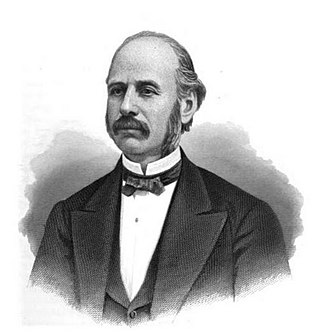
Amasa Stone, Jr. was an American industrialist who is best remembered for having created a regional railroad empire centered in the U.S. state of Ohio from 1860 to 1883. He gained fame in New England in the 1840s for building hundreds of bridges, most of them Howe truss bridges. After moving into railroad construction in 1848, Stone moved to Cleveland, Ohio, in 1850. Within four years he was a director of the Cleveland, Columbus and Cincinnati Railroad and the Cleveland, Painesville and Ashtabula Railroad. The latter merged with the Lake Shore and Michigan Southern Railway, of which Stone was appointed director. Stone was also a director or president of numerous railroads in Ohio, New York, Pennsylvania, Indiana, Illinois, Iowa, and Michigan.
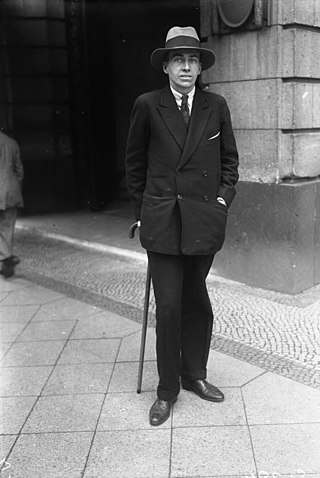
Cornelius Vanderbilt IV was a newspaper publisher, journalist, author, and military officer. He was an outcast of high society, and was disinherited by his parents when he became a newspaper publisher. He desired to live a "normal" life but was burdened by large debt and could not maintain the lifestyle associated with his family's social position to which he had become accustomed.
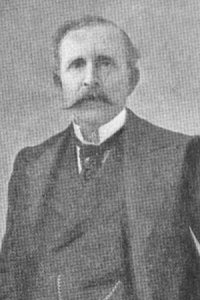
William Arthur Law, better known as Arthur Law, was an English playwright, actor and scenic designer.
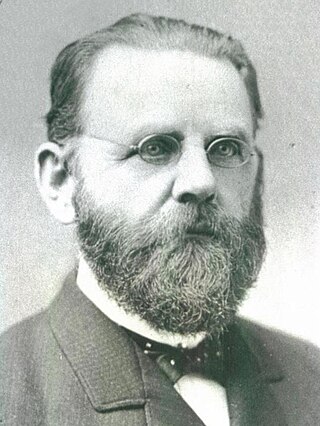
Nathan Randolph Vail was a mine operator in Arizona Territory, and a landowner in 19th century Los Angeles, California. He was a member of the Los Angeles Common Council, the legislative body of the city.

Florence Adele Vanderbilt Twombly was an American socialite and heiress. She was a member of the prominent Vanderbilt family. She and her husband Hamilton McKown Twombly built Florham, a gilded age estate in Madison, New Jersey.

Cornelius Jeremiah Vanderbilt was an American socialite and member of the Vanderbilt family. After having a troubled relationship with his father, Cornelius Vanderbilt, he eventually committed suicide at the age of 51.

The Kew Mortuary or Dead-House is a small, shed-like building, approximately 3.75 by 2.25 metres and 2.8 metres high, attached to the back of Caxton House, 110 Kew Green, just to the east of Kew Bridge on Greyhound Lane facing Westerley Ware. This Victorian mortuary building retains an original slate slab.

935–939 Broadway is a six-story Italianate brownstone structure designed by the architect Griffith Thomas in the Flatiron District of Manhattan, New York City.
Gardiner Greene Howland was a prominent American businessman who was a founding partner in the merchant firm of Howland & Aspinwall and a co-founder of the Pacific Mail Steamship Company.

647 Fifth Avenue, originally known as the George W. Vanderbilt Residence, is a commercial building in the Midtown Manhattan neighborhood of New York City. It is along the east side of Fifth Avenue between 51st Street and 52nd Street. The building was designed by Hunt & Hunt as one of the "Marble Twins", a pair of houses at 645 and 647 Fifth Avenue. The houses were constructed between 1902 and 1905 as Vanderbilt family residences. Number 645 was occupied by William B. Osgood Field, while number 647 was owned by George W. Vanderbilt and rented to Robert Wilson Goelet; both were part of the Vanderbilt family by marriage.
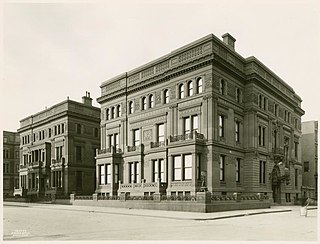
The Triple Palace, also known as the William H. Vanderbilt House, was an elaborate mansion at 640 Fifth Avenue between 51st Street and 52nd Street in Midtown Manhattan, New York City. The urban mansion, completed in 1882 to designs by John B. Snook and Charles B. Atwood, was owned by members of the Vanderbilt family. It was composed of two portions: a single-family unit to the south and a two-family unit to the north. William Henry Vanderbilt owned and lived in the southern portion. Two of his daughters, Emily Thorn Vanderbilt and Margaret Louisa Vanderbilt Shepard, along with their respective families, occupied the two residences in the northern portion.

4 Park Avenue is a 22-story building in the Murray Hill neighborhood of Manhattan in New York City. Designed by Warren and Wetmore, the structure was built for Alfred Gwynne Vanderbilt and opened in 1912 as a hotel. It is along the west side of Park Avenue between 33rd and 34th Streets. Following a renovation by Schuman, Lichtenstein & Claman between 1965 and 1967, the top 18 stories have been used as residential apartments. The lowest three stories above ground, as well as three basement levels, are used as commercial space and carry an alternate address of 6 Park Avenue. As of 2021, the building is owned by The Feil Organization.
References
- ↑ "Death List of a Day - Col. George N. Terry". The New York Times. June 4, 1899. Retrieved November 7, 2023.
- 1 2 "1850 United States Federal Census", United States census,1850;Brookhaven, Suffolk County, New York; roll 106, page 190a, line 38. Retrieved on November 9, 2023.
- 1 2 "Col. George N. Terry Dead: He Was The First Proprietor of the Hoffman House". The Evening Star. June 3, 1899. Retrieved November 7, 2023.
- ↑ "Suicide of C. Vanderbilt: Particulars of His Life". The Evening Star. April 5, 1882. Retrieved November 7, 2023.
- 1 2 3 "Funeral of George N. Terry: One of a Noted Family of Bonifaces, He Began as a Bellboy in New York". The Brooklyn Daily Eagle. June 7, 1899. p. 8.
- ↑ "Personal Intelligence". The Brooklyn Daily Eagle. June 5, 1899.
- ↑ "General News". The New York Times. November 7, 1864. ProQuest 91847912.
- ↑ "New Broadway". The New York Times. January 11, 1866. p. 4. ProQuest 92047534.
- ↑ "That New Broadway". The New York Times. January 16, 1866. ProQuest 92318636.
- ↑ "Reopening of the U.S. Hotel". The Sun. March 29, 1867. p. 4.
- ↑ "Poisoned by Gas: Fatal Case of Suffocation". New York Daily Herald. November 6, 1869. p. 7.
- 1 2 3 4 5 6 7 8 9 10 "The Vanderbilt's Will: Continuation Of The Contest Between The Commodore's Heirs". The New York Daily Herald. February 27, 1878. p. 5.
- 1 2 3 Stiles 2009.
- ↑ "George N. Terry of the Hotel French". The Lima News. July 11, 1892. p. 8.
- ↑ "New Management: E.B. Hawkins Succeeds William C. Terry & Co., as Manager of the Hotel French". The Times-Democrat. June 1, 1896. p. 5.
- ↑ "Double Tragedy: Patrick Dowd Kills George Haas and Then Shoots Himself". Vol. 24, no. 102. The Buffalo Evening News. August 8, 1892.
- ↑ "Personal". The Omaha Evening Bee. July 25, 1872.
- ↑ "Gen. Robert Tyler, Jessup, George N. Terry, C. Vanderbilt, Bernardo E. Carneiro". Connecticut Museum of Culture and History. Retrieved November 7, 2023.
- ↑ "The Vanderbilt Will: Conclusion of Cornelius J. Vanderbilt's Searching Cross-Examination". The New York Herald. December 29, 1877.
- ↑ "Cabin Passengers By The Steamship City Of Richmond". Liverpool Mercury. September 16, 1880. p. 6.
- ↑ "Mr. C.J. Vanderbilt's Trip". The New York Times. September 5, 1880. ProQuest 93823199.
- ↑ "The Hotels Crowded: Some of the Arrivals in the City Yesterday". The Washington Post. March 2, 1881. ProQuest 137750986.
- ↑ "Mr. Chittenden's Reception: Garfield and Hayes and Other Distinguished Guests Present". The Washington Post. March 3, 1881. ProQuest 137762265.
- ↑ "Passengers For Europe". The New York Times. July 20, 1881. ProQuest 93970510.
- ↑ "Cabin Passengers by the Steamship Arizona". Liverpool Mercury. July 28, 1881. p. 6.
- ↑ "Passengers Arrived". The New York Times. September 27, 1881. p. 8. ProQuest 93940387.
- ↑ "Chicago Arrivals". Chicago, Illinois: The Chicago Tribune. January 25, 1882. p. 6.
- ↑ "Hot Springs Sprays: Events As They Occur In The Valley of Vapors". The Daily Arkansas Gazette. February 2, 1882. p. 4.
- 1 2 "Suicide of Cornelius J. Vanderbilt Yesterday Afternoon". The Chicago Tribune. April 3, 1882. p. 2.
- 1 2 3 4 5 6 7 8 9 10 11 "Mr. Vanderbilt's Suicide: The Coroner's Jury Find That It Was Done Under Mental Depression". The New York Times. April 7, 1882. p. 8. ProQuest 94092384.
- 1 2 Associated Press (April 3, 1882). "A Chapter of Horrors: C.J. Vanderbilt's Tragic End". Vol. 3, no. 149. The Buffalo News. p. 9.
- 1 2 "A Vanderbilt Suicide: Cornelius, Jr., Third Son of the Commodore, Ends His Existence". The Cincinnati Enquirer. April 3, 1882. p. 1.
- ↑ Cooper & Howe 2021.
- ↑ Cooper & Howe 2021, pp. 85.
- ↑ Cooper & Howe 2021, pp. 86.
- ↑ "Suicide of C.J. Vanderbilt: He Shoots Himself In The Head in the Glenham Hotel". The New York Times. April 3, 1882. p. 1.
- ↑ "The Last Will and Testament of Cornelius Jeremiah Vanderbilt". October 25, 1881.
- ↑ "Contesting C.J. Vanderbilt's Will". The Washington Post. May 30, 1882. ProQuest 137816923.
Sources
- Cooper, Anderson; Howe, Katherine (September 21, 2021). Vanderbilt: The Rise and Fall of an American Dynasty. HarperCollins. ISBN 0062964615.
- Stiles, T.J. (2009). The First Tycoon: The Epic Life of Cornelius Vanderbilt. Alfred A. Knopf. ISBN 9780375415425.